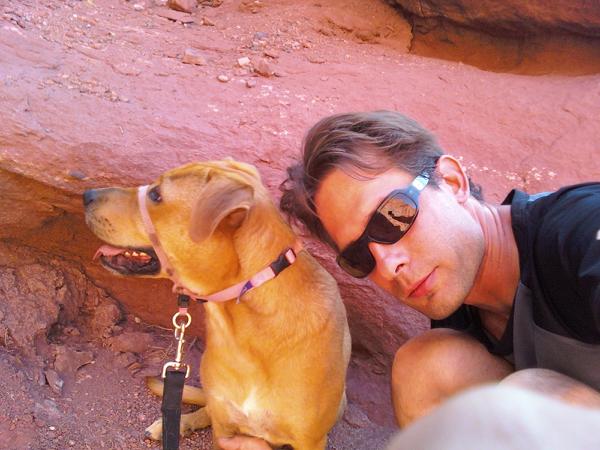One of the most exciting and rewarding parts of public relations is the opportunity to work with the media. In the past, we’ve shared insight from local and national journalists through our “Meet the Media” blog posts. I am incredibly excited to bring back Meet the Media in 2012, and look forward to helping you get to know the people who produce the news you consume every day.
Our first Meet the Media post of 2012 features Ryan Budnick, content producer for Denver’s ABC affiliate, KMGH-TV. Ryan wears many hats for 7 News, and shares his take on the ever-changing TV news landscape, what’s newsworthy and PR pet peeves. When he’s not working (which isn’t often), Ryan is most likely mountain biking, rock climbing or enjoying the outdoors with his pup, Lucy.

Xstatic PR: You began your career in newspaper. What path did you take to now being content producer for KMGH-TV in Denver?
Ryan Budnick: It purely was by accident. I was a newspaper reporter when I left Washington State (University) and moved to Denver. I started working at Channel 2 as an assignment editor, and have had various titles and duties over the years.
Traditional roles in a newsroom are becoming more nebulous. We are expected to perform various tasks including assigning crews, writing stories, picking up a camera and shooting and editing a story, or doing research and producing a segment. And, that can all be in the same day.
X: So, clearly, in your role, you don’t just sit behind a desk all day and take calls. What are all the ways you gather stories?
RB: When I began in journalism, it was the nascent days of the Internet. Hardly anybody had wireless phones and social media wasn’t even an idea yet. So much has changed.
Things I didn’t even use three years ago like social media feeds and deep Internet searches are important staples of how I dig for stories. But, that isn’t to say the new ways are better. I get more reliable information from connections I’ve cultivated the old-fashioned way, by work, time and trust.
X: What are the biggest changes in TV news over the last several years?
RB: I think the biggest change is that it really isn’t TV news any longer. TV is just one of several formats KMGH uses to disseminate its product.
Many outlets break news on social media now, something unheard of just a couple of years ago. I think you’re seeing the change of how newsrooms are adapting to a new form of journalism driven by the reader or viewer. Content is key and people are given many, many ways to access content and pick and choose what they consume.
X: What has been the most memorable news story you’ve ever been involved in covering?
RB: It’s funny, but after 15 years in journalism, a lot of them begin to blend together. As a journalist, the stories that left the biggest impressions are those with people overcoming the odds. I think being around people like that has made me want to be a better person, even in the role of impartial journalist.
X: In Channel 7’s eyes, what is news?
RB: Something that is unique, hard-hitting and gets answers to the tough questions. That is the tenor our newsroom has adopted for quite some time now. There is a large emphasis on investigative pieces.
X: You’ve said when you take a couple days off, you often come back to more than 1,300 emails. Which pitches get your attention?
RB: You should think of the subject line as a headline with the goal of drawing the reader in. Given the amount of traffic you are contending with, that can be one of the biggest determining factors to whether your pitch even gets read. Also a strong working relationship with a journalist goes a long way. If I have had a good experience with a PR person in the past, I will read their emails right away.
X: What’s your biggest PR pet peeve?
RB: Not coming prepared. That covers a lot of ground, but when reps don’t know the basics, such as how many news broadcasts we have and when they run, or how often a paper gets published and when, you’ve ruined your initial impression with that journalist or newsroom.
X: What do you wish more PR people knew about TV news and how the newsroom works?
RB: I find the most successful PR people have spent some time in journalism, either as a professional or as an intern. Newsrooms are microcosms onto themselves. Each one is different, but we all basically follow the same parameters. If a PR person wants to really be efficient, find out when the newsroom meetings are held during the day. Information like that can be a very powerful tool in the right hands.
X: You’re a big outdoorsman. What’s on the agenda this spring/summer?
RB: Hoping to get in more mountain biking and rock climbing than in the past few years. Other than that, staying injury free and collecting as many memories of great outings and sunsets as possible.
-Stacey Sepp
- Adapted Sport Leadership & Business Symposium (LABS) Moves to Virtual Conference on October 15
- AspenRidge Recovery Offering Hardship Scholarships, Free Mental Health Resources to Community During COVID-19 Crisis
- AspenRidge Recovery Launches First Fully Online Treatment Program for Mental Health, Trauma, and Substance Use Disorders in Colorado
- All In Sport Consulting to Launch Adapted Sport Leadership & Business Symposium (LABS) in Denver This October
- Denver Dogs Are Tying the Knot TOMORROW – And You’re Invited!

Great post with helpful information for PR professionals! Thank you!